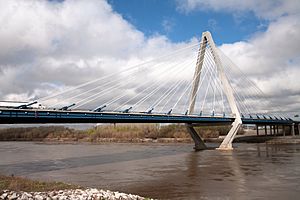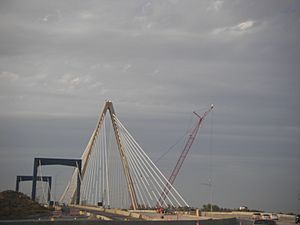Christopher S. Bond Bridge (Kansas City, Missouri) facts for kids
Quick facts for kids Christopher S. Bond Bridge |
|
|---|---|

Paseo Bridge and downstream replacement Bond bridge in December 2009
|
|
| Coordinates | 39°07′29.70″N 94°34′03.30″W / 39.1249167°N 94.5675833°W |
| Carries | 6 lanes of |
| Crosses | Missouri River |
| Locale | Kansas City, Missouri |
| Official name | Christopher S. Bond Bridge |
| Maintained by | MoDOT |
| Characteristics | |
| Design | Single tower cable-stay |
| History | |
| Opened | September 27, 2010 |
- For the new bridge of the same name in Hermann, Missouri see: Christopher S. Bond Bridge (Hermann)
The Christopher S. Bond Bridge is a modern bridge in Kansas City, Missouri. People sometimes call it the New Paseo Bridge. It's a special type of bridge called a cable-stayed bridge, which means it uses strong cables to hold up the road. This bridge crosses the wide Missouri River.
The Bond Bridge helps cars travel on major highways like I-29, I-35, and US 71. It first opened for some traffic on September 27, 2010. All lanes were open by December 18, 2010. This new bridge replaced an older one called the Paseo Bridge. The bridge is named after Christopher "Kit" Bond, who used to be the Governor of Missouri and a United States Senator.
Contents
Building a New Bridge for Kansas City
The old Paseo Bridge was getting old and needed to be replaced. So, on November 14, 2007, the MoDOT announced plans for a brand new bridge. This new bridge would be much bigger and more modern.
How the Bond Bridge Was Designed
The Christopher S. Bond Bridge is a dual-span cable-stayed bridge. This means it has two main sections supported by cables. These cables connect to a tall, delta-shaped tower, also called a pylon. This pylon stands about 260-foot (79 m) tall. It rises even higher, about 316 feet (96 m), above the Missouri River.
The new bridge was designed to carry more cars than the old one. It has three lanes for southbound traffic and four lanes for northbound traffic. One of the northbound lanes is an "auxiliary lane," which helps cars get on and off the highway. The bridge was also built so it could easily be made even wider in the future if needed, without major changes.
Building Around the Airport
In December 2007, there was a small problem. The Federal Aviation Administration (FAA), which manages air traffic, worried that the tall pylon might get in the way of planes flying to and from Kansas City Downtown Airport. This airport is only about a mile west of the bridge.
To solve this, in August 2008, the FAA changed the flight paths for planes. This made sure planes had more than 700 feet (210 m) of clear space above the pylon. This way, both the bridge and the airport could operate safely.
Construction and Demolition
Building the Bond Bridge started in April 2008. It was built just downstream from the old Paseo Bridge. This was a smart idea because it meant the old bridge could stay open. Cars could keep using the Paseo Bridge while the new Bond Bridge was being built next to it.
Once the Bond Bridge was open, the old Paseo Bridge was no longer needed. Demolition of the Paseo Bridge began, and it was completely taken down by July 1, 2011.
The Bigger Project
The Christopher S. Bond Bridge was part of a much larger project. This project cost about $245 million. It involved upgrading a 2-mile (3.2 km) section of the I-29/I-35 highway corridor to six lanes.
Several construction companies worked together on this big project. The bridge itself was designed by Bradley Touchstone from the DodStone Group. This company also designed another very long cable-stayed bridge in North America, the John James Audubon Bridge in Louisiana.



